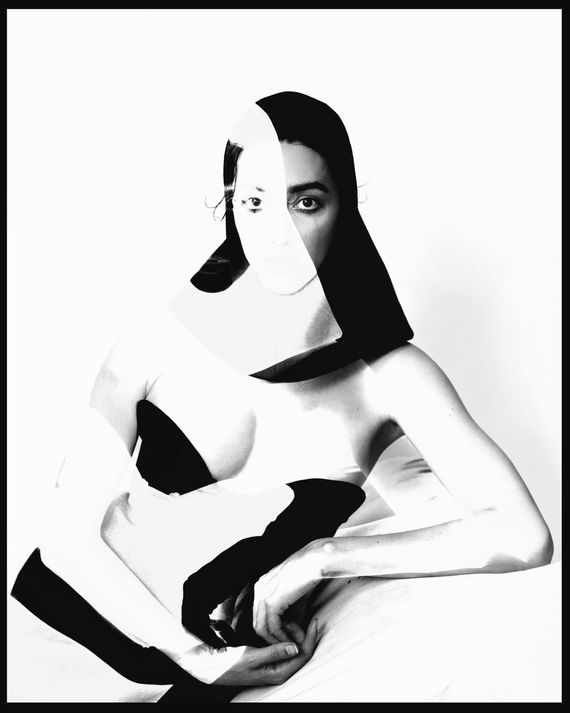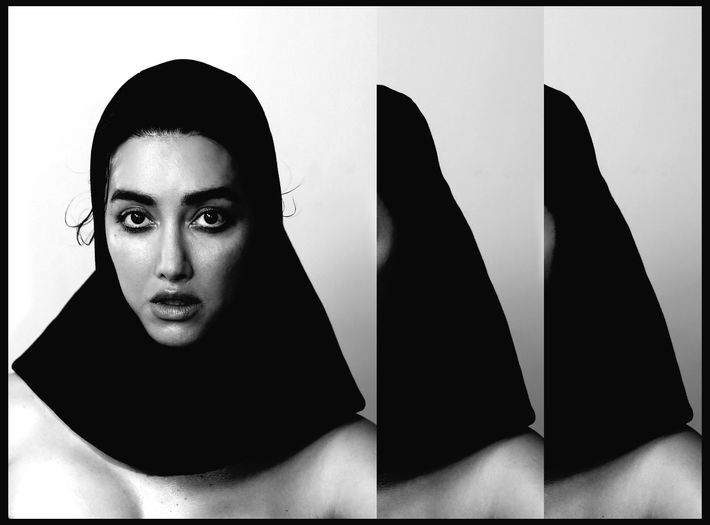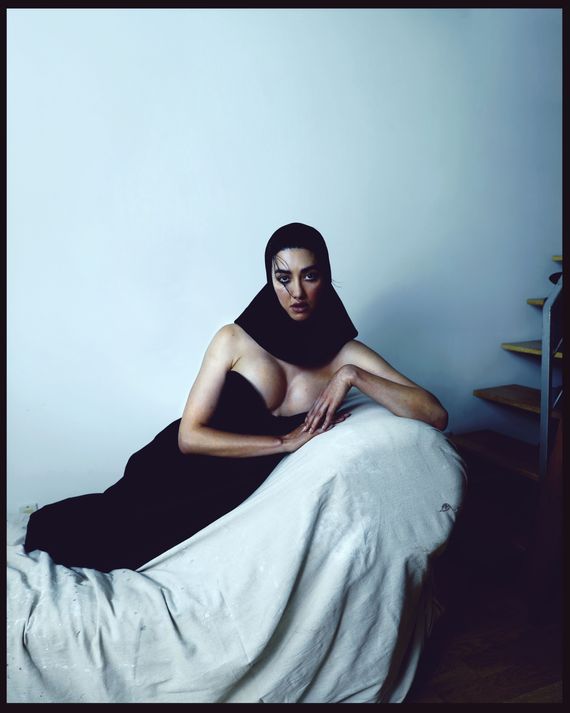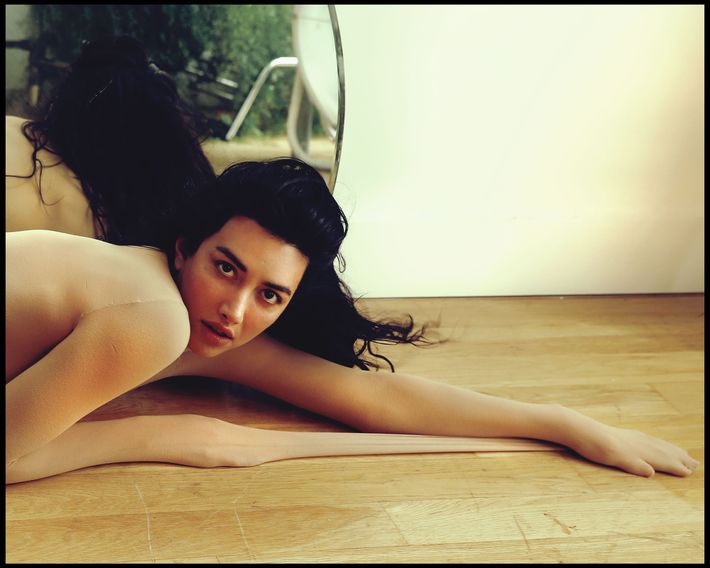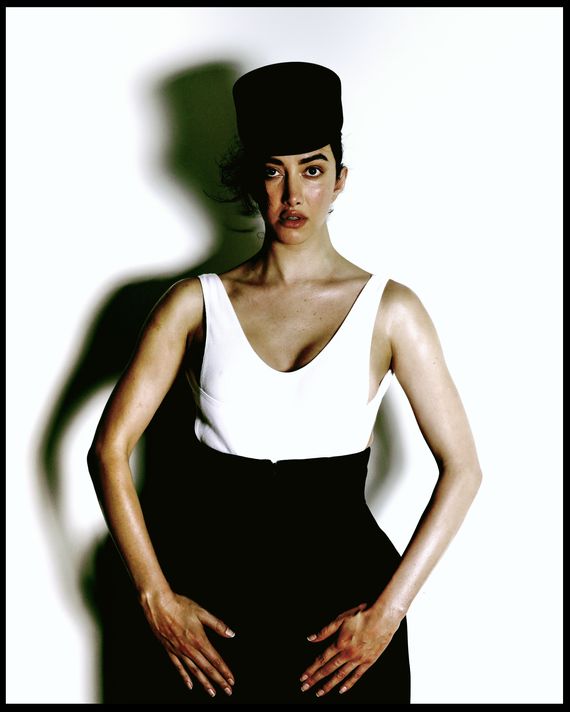
ALAÏA cap, bodysuit and trousers.
Photo: Ashley Peña
White jacket, black briefcase, white jacket, black briefcase …
I’m roving the expanse around the Temple of Dendur at the Metropolitan Museum of Art, scanning the enormous, greenhouselike gallery space for someone — anyone — who matches that description. The day prior, I had received an email from the artist Martine, who recently decided to drop her last name like Cher and Madonna before her: “I’ll be in the white jacket, black briefcase.” But there’s no one here with either item, much less both at once. I begin to wonder, could the artist — whose work deals so heavily in shifting personae, using herself as a canvas to slip into other forms — be testing me? Perhaps she has disguised herself, hiding in plain sight like Tom Cruise in Mission: Impossible, delighting in babushka drag as I try and fail to find her.
And then I spot her by the temple looking like herself, or at least a version of Martine that I would have been able to recognize before finally meeting in person. She’s wearing a white jacket and carrying a black briefcase, just as she’d told me she would be. We take a seat beside the moatlike pond in front of the temple. “I’m always in costume,” she says, laughing. Today’s look is very “Spy vs. Spy,” with Martine in all black except for her oversize white translucent raincoat. “If I say the designer, I’m going to sound really bougie. It’s a new purchase, okay?” she says, faux defensively, as if she were on trial for the garment’s acquisition before contradicting herself. Then, “It was my mom’s,” she adds in a hushed, wistful tone, trying on a new character for whom that might be true. Martine’s narrow cat-eye sunglasses came from a Canal Street vendor. “They look very expensive, but they don’t even have a brand,” she explains. “They’re brandless, like me!” She flips over her briefcase to find a small circular sticker that reads “6” stuck to the bottom of it: “This is a 6. Or maybe a 9. I really want a silver bulletproof one in case I have to block something. Imagine, the chopper pulls up here.” She points to the gallery’s glass-paneled wall. “We backflip toward the window, get the amulet, and we’re out.”
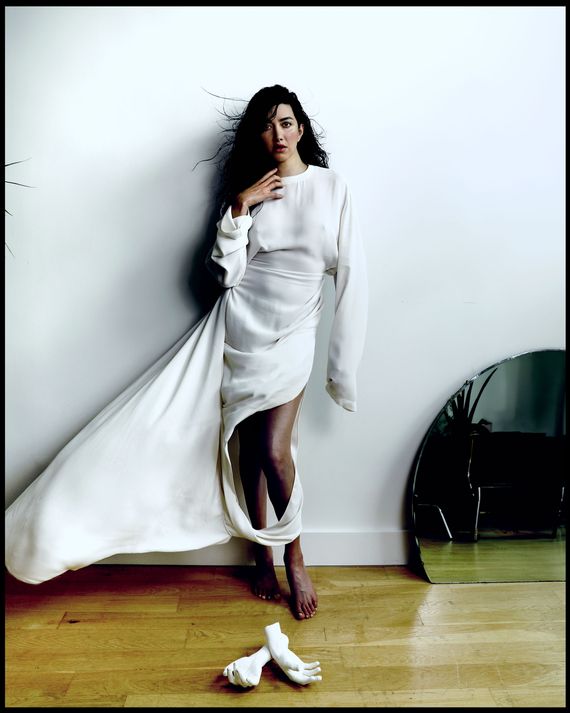
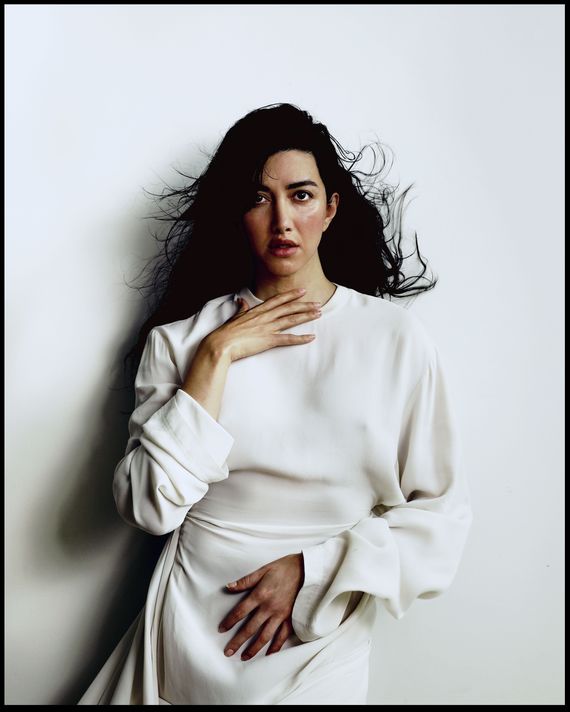
ACNE STUDIOS dress. Photos: Ashley Peña.
ACNE STUDIOS dress. Photos: Ashley Peña.
Martine loves slipping into playful bits like this, where she poses a hypothetical and dons a new voice on a whim — though not to the same degree as Vanesja, the character she plays in Julio Torres’s new show, Fantasmas. A performance artist, at least in theory, Vanesja — the j is silent — has been acting as Julio’s talent agent as part of some unexplained “piece.” But she’s been doing it for so long that she’s actually just become his agent, and a cynical, money-driven one at that, who pushes him to pursue such blatantly exploitative projects as a “Gaytinx”-themed credit-card commercial and “a Zappos original” called How I Came Out to My Abuela. Martine, the actor behind the character, on the other hand, is less eager for mainstream success, despite having achieved a lot of it as a multidisciplinary artist whose work blends photography, sculpture, costume design, film, modeling, music, and other media, with all of that labor performed by Martine herself. “A lot of the reason I was working alone as an artist was because I was objectified in so many venues that pretended to be an opportunity,” she says — not just in the art world but in her media coverage as well. “There was a loss of so much control. Especially if you have, you know, dysphoria about yourself, putting your image in the hands of someone you don’t even know can be really jarring.” Torres, to whom Martine cedes control in this project, has proven to be a worthy collaborator. She’s relieved, I surmise, which makes sense: A bit is always more fun when someone else plays along.
Born and raised in Oakland, California, and then later in Vermont, Martine has been making art for as long as she can remember. “Art was my tool to make sense of my life and how I came to understand myself,” she says. A Rhode Island School of Design graduate who has now shown work everywhere from the Venice Biennale to bus shelters across America, she first caught the art world’s attention in the early 2010s with her still and moving self-portraiture. Her work explores the ways in which, as women, we make ourselves legible for all manners of consumption, or else find ourselves packaged into consumable goods. Dolls and mannequins often figure into her pieces, recalling, though distinct from, the ways in which earlier artists like Laurie Simmons and Greer Lankton had used such props to examine womanhood and misogyny. Cindy Sherman, Frida Kahlo, Nash Glynn, and Nina Arsenault also come to mind, given that Martine plays dual roles as artist and muse, and her body often serves as her canvas.
AREA hood, CARVEN dress.
Photo: Ashley Peña
In 2018, Martine exhibited Indigenous Woman, a 124-page issue of a fictitious fashion magazine complete with ads and editorials that make explicit what is usually left ignored or at best unspoken: The product is colorist beauty ideals; the product is authentic indigeneity; the product is patriarchal self-abnegation; the product is buying your way into a self. (One of my favorite pages is a retro-mod shoe ad, in which Martine looks reminiscent of Goldie Hawn on Laugh-In. “WHO R U?” the copy reads. “IDENTITY BOOTS.” Her humor shines through.) The piece, like Martine’s greater oeuvre, reveals a fluency in various consumer dialects: advertising, fashion imagery, music videos, erotica. “I was raised on Making the Video,” she says. “America’s Next Top Model, Antiques Roadshow. That Making the Band show with the creator of the Pussycat Dolls, what was it called … The Search for the Next Doll!”
She laughs after hearing those words tumble out of her mouth; what a prescient title for the 2007 reality competition, given the whole “tipping point” moment that followed. “We all became pick-mes after that,” she says jokingly.
Both Indigenous Woman and Supremacy, a billboard first shown at the Whitney in 2022 that features Martine in lingerie as she’s besieged by a dozen Barbie dolls — think Gulliver’s Travels by way of the pink aisles of an Aryan Toys “R” Us — complicate the idea that simply finding and claiming one’s identity from some endless taxonomy of labels is always going to be a liberatory act. Finding the right words to describe yourself is important, even necessary, but in a world in which corporations will always discover those words, and with them a new demographic, how revolutionary is the act of self-identification alone? Like Río Sofia’s Forced Womanhood! series, Martine’s work exposes how, under capitalism, escaping one such trap usually just leads you right into another.
AREA hood.
Photo: Ashley Peña
The characters in Fantasmas, most of them creatives, find themselves mired in similar questions as they struggle to survive by selling their art without destroying themselves in the process. Vanesja, Martine’s character, is one of the few who seems to have solved that puzzle: She simply gets other people — her clients, like Julio and a former teen idol played by Teen Wolf’s Dylan O’Brien — to do her dirty work for her. “I don’t want to be the spokesperson for a product or a brand, which is, I guess, the parallel between me and Vanesja,” Martine says. Except instead of saying “no” to “the machine,” as she calls those nebulous powers that be, “Vanesja’s like, ‘You do it. You do it, and make me money.’ She’s like a house mother. That’s what a PR person is. She’s like, ‘You make money,’ so she makes money. There’s a parallel there to a lot of things. A record label. A gallery. They are putting you forward, and if you don’t make money, they don’t make money.” Beneath Vanesja’s heavy transatlantic accent — a choice that Martine brought to the role, Torres later tells me by phone — lies a hilarious but incredibly bleak critique of contemporary culture industries. While Vanesja has found financial success and stability as an artist, it’s only because her performance art is just being a literal businessperson. In Fantasmas, the easiest way to make money as an artist is simple: Don’t be an artist.
“The part was 1,000 percent written for Martine,” says Torres, a former Saturday Night Live writer whose debut film, Problemista, opened in theaters earlier this year. In fact, the character began years before as an inside joke between them. She would call him up and start pretending that she couldn’t talk, that she had “big names” in the room with her like Jake Gyllenhaal or some other A-lister and that she had to go. “Without Martine, there would be no Vanesja. We would have had to come up with something else,” adds Torres.
The two met in 2016 when Martine was cast in a series of sketches that Torres had written with the comedian Max Wittert for Más Mejor’s YouTube channel. In them, she competes in “the Pre-Fall Fashion Olympics,” sweeping such categories as “feigning surprise when finding out a dead relative left her everything in the will” and “storming into a room, knocking everything off a table, snatching a necklace off her neck, collapsing to the ground, and screaming ‘GET OUT!!’ at her teammates.” Then, as now, Martine is a natural in a cast of working comedians, which includes frequent Torres collaborators like River L. Ramirez and Ana Fabrega, both of whom also pop up in Fantasmas. “She really reminds me of Tilda,” says Torres, referring to Tilda Swinton, his Problemista co-star. “The brilliance of their physicality, just how invested they are in having fun and the work being good. It was such a joy to think about the hair, the voice, and the clothes and then see Martine fill in the gaps of this character. In any other hands, she would not have been as fully realized as she was.”
AREA hood, CARVEN dress.
Photo: Ashley Peña
With roles in all of Torres’s recent work, including his previous HBO comedy, Los Espookys, and another forthcoming project that she’s not able to discuss yet, plus Sebastián Silva’s Rotting in the Sun, Martine’s IMDB credits grow longer with each passing day. She calls Silva’s film “guerrilla,” adding that “it felt less like acting in a movie and more like living with a camera in your face.” Plenty of “firsts” happened on set for the actress. “I had never been in an orgy before, let alone surrounded by naked men every day. There sometimes wasn’t clarity between filming on set and life on a nude beach,” she says. “This is essentially Method acting, right?”
There is a bit of espionage in Martine’s Hollywood turn, given that she’s interested in becoming a filmmaker herself. “In a lot of ways, taking on this subservient acting role is teaching me how to become a director,” she says. “It feels like data, like I’m a mole on the inside learning how to operate as I venture deeper into Hollywood.” Once again, our conversation has wound its way back to spies. She explains why she’d asked me to meet her by the Temple of Dendur. “Remember when that diamond necklace forgery was dropped into the pool?” she asks at one point, referencing Ocean’s 8. “That’s America’s history! This is where Hollywood made Ocean’s … 15, I believe? 16?”
“17,” I correct her, not daring to decline her invitation to the bit.
Although Martine has shifted her focus from the gallery to the screen, she’s careful to note that this pivot of hers isn’t zero-sum. “I’ve always been a side-hustle girl, whether it was a modeling gig here or there or dancing at nightclubs or hosting some party,” she says. “Acting is kind of supplementing my work as an artist in a funny way, but now people seem to believe that that’s the career I should pursue. Do you think so?”
“They don’t feel that dissimilar,” I tell her. “Acting feels like a natural extension of the work you’ve been doing as an artist. You’ve always been playing roles, slipping into characters.”
“I think so,” Martine says. “I just didn’t call it that. I needed it to happen in a room with only mannequins and a camera on a timer so I could channel that sexy girl or that powerful, that elusive — whatever it was I was trying to embody. I had all the time in the world. I guess Marina would call that process,” she says, referencing Marina Abramović. The pace of shooting television, trusting an entire cast and crew to create something together that she won’t get to see until it airs a year later, has obviously been quite a different experience. “I have no idea what this content is that is about to drop, and it is using my image. I guess that wouldn’t be such a big deal if my image wasn’t the tool that I use to make all of my work. But it’s meta. I do play an artist trying to make it in New York.”
BALENCIAGA dress.
Photo: Ashley Peña


